P-51D Mustang
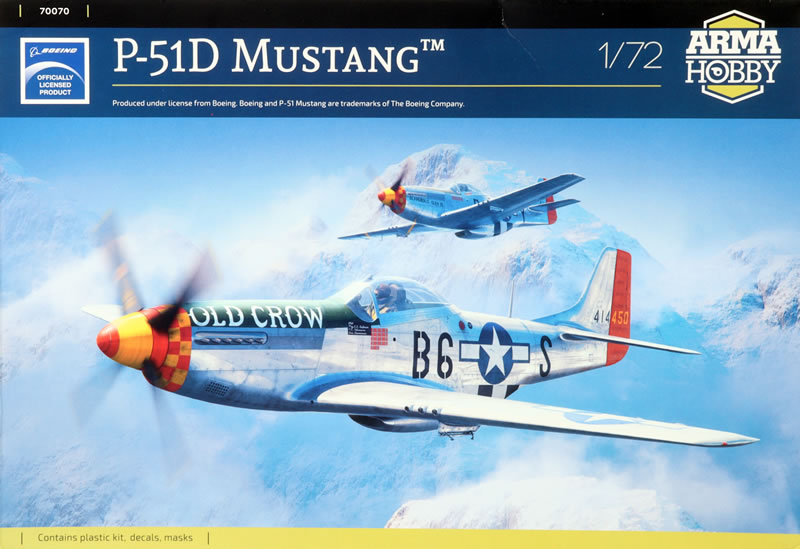
Arma Hobby, 1/72 scale
S
u m m a r y : |
Description and Item No.: |
Arma Hobby Kit No. 70070 - P-51D Mustang |
Contents and Media: |
107 parts in grey plastic; eight parts in clear plastic; self-adhesive die-cut canopy and wheel masks; markings for three aircraft options; undercarriage alignment jig included on the clear sprue. |
Price: |
€22.50 plus shipping available online at Arma Hobby
£22.49 EU Price (£18.74 Export Price) Plus Shipping at Hannants
and hobby retailers worldwide |
Scale: |
1/72 |
Review Type: |
First Look |
Advantages: |
High quality moulding; excellent surface textures and detail; accurate; many useful options; includes ample ordnance; high quality decals. |
Disadvantages: |
End-opening box. |
Recommendation: |
This new P-51D is the logical next step in Arma Hobby's 1/72 scale Mustang dynasty. The kit is as impressive as its Arma Mustang predecessors - crisp surface textures, high moulding quality, many useful options and a very high level of detail.
This a great package with the plastic as well as self-adhesive masks.
Highly Recommended. |
Reviewed by Brett Green

The North American P-51D Mustang remains one of the most recognisable fighters of the Second World War — a classic blend of elegance, performance and lethal efficiency. Developed from a lineage that began in 1941 with the Allison-powered Mustang Mk.I, by mid-1944 it had evolved into a thoroughbred long-range escort fighter capable of reaching Berlin and back from English bases.
Powered by the Packard-built Rolls-Royce Merlin V-1650-7, the P-51D produced 1,695 horsepower and could reach more than 430 mph at altitude. It combined this power with outstanding range thanks to efficient aerodynamics and large internal fuel tanks supplemented by jettisonable drop tanks.
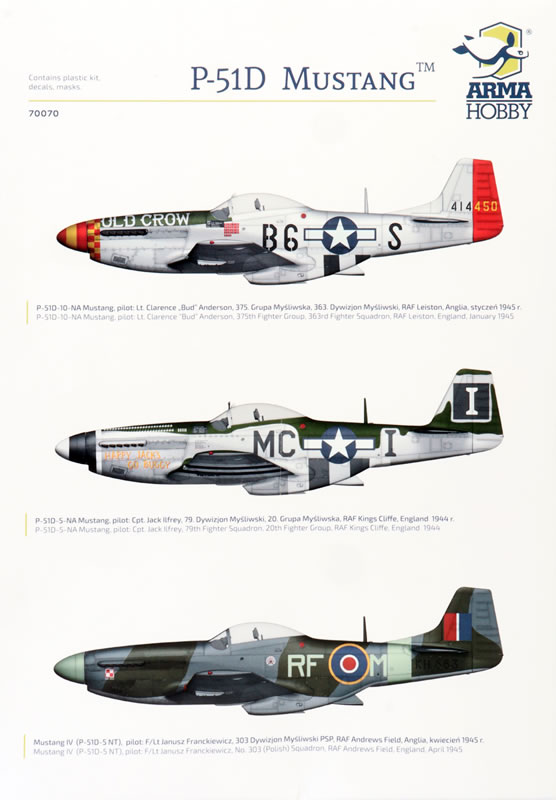
The introduction of the cut-down rear fuselage and the distinctive bubble canopy transformed pilot visibility — a critical advantage in air combat — while the six .50-calibre Browning machine guns gave it devastating firepower.
Operational service began with the 8th Air Force in the spring of 1944, where Mustangs quickly became the mainstay of Allied bomber escort operations. They swept the skies clear of the Luftwaffe’s dwindling fighter arm, ensuring the success of the strategic bombing campaign and later supporting the Allied invasion of Europe. The Mustang also proved its versatility in the ground-attack role, where its speed and agility made it an effective fighter-bomber.
By war’s end, the P-51D had established itself as the definitive Mustang variant. Fast, agile, and supremely capable at high altitude, it remained in front-line service with numerous air forces well into the 1950s and even saw combat again in Korea.
The P-51D Mustang remains a powerful symbol of Allied air superiority in the Second World War, a perfect blend of American engineering and British engine design that changed the course of the air war over Europe.
Arma Hobby has developed a strong following since 2020 thanks to their highly detailed and beautifully textured 1/72 scale aircraft releases, also venturing into 1/48 scale from 2021.
Arma Hobby kicked off a 1/72 scale P-51B/C Mustang family in 2021. They have now expanded the range to include a new 1/72 scale P-51D Mustang.
Arma Hobby's new 1/72 scale P-51D Mustang comprises 107 parts in grey plastic, eight parts in clear plastic, self-adhesive die-cut canopy and wheel masks, markings for three aircraft options and an undercarriage alignment jig included on the clear sprue
This model is in the standard series so we do not find photo-etched or 3d printed parts. Arma has, however, included self adhesive masks and you may download files for 3d printing your own detail parts. The die-cut masks are the paper "Kabuki" style.
The grey plastic parts are delivered on two sprues. Moulding quality is excellent with no flaws or visible moulding imperfections on my sample. Arma’s website advises that long-run metal moulds are used for their kit production, and it shows.
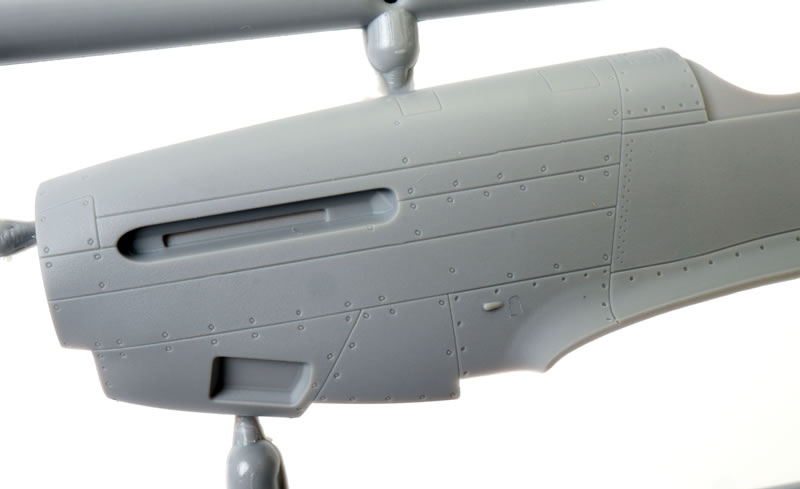
Being a long-run kit, the parts are moulded with all the alignment aids that you would expect including locating pins, holes and tabs.
The larger parts are moulded with a satin finish. Surface textures are just gorgeous. Recessed panel lines, circular fastener heads and other structural details are very fine.
The fabric texture on the elevators are represented by very subtly raised rib tapes. The elevators are moulded as part of the horizontal stabilisers.
The fuselage is supplied as left and right halves with a few elements that allow some important options.
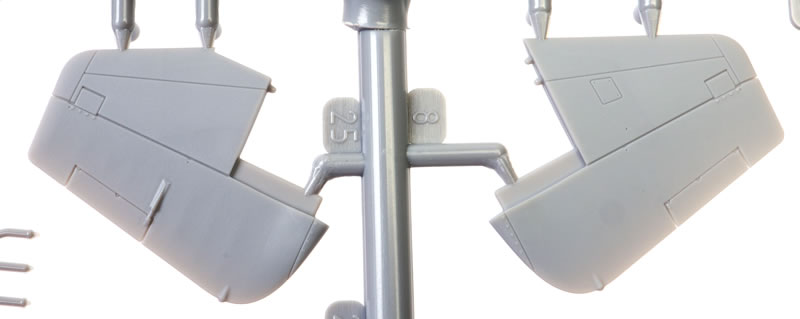
The most obvious is the separate rudder, fin and horizontal stabilisers. Two sets of each are included. One set represents the fin without the fillet, while the second depicts the later fin filleted version.
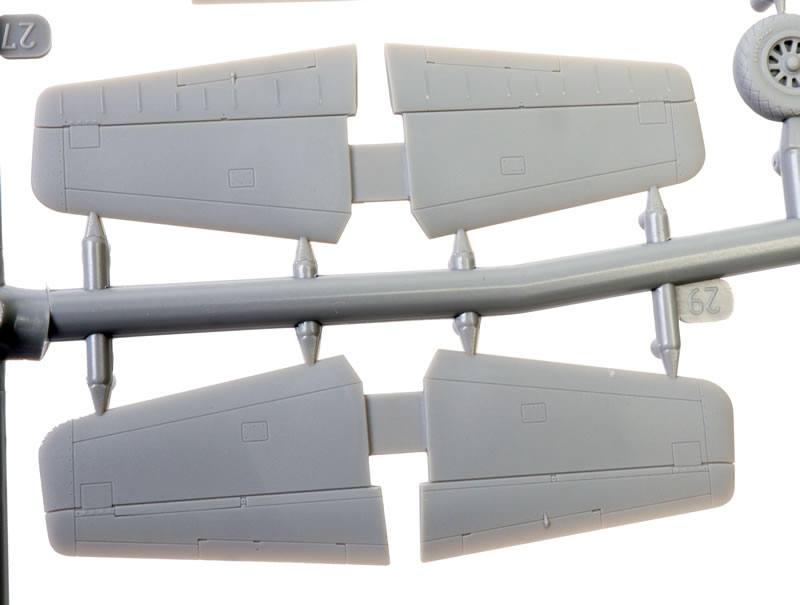
The fillet is moulded in the centre of the horizontal stabilisers.
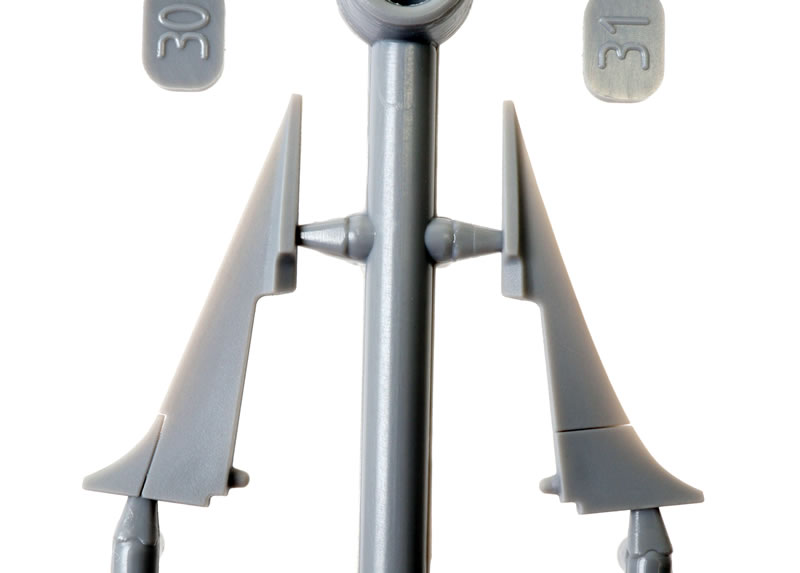
The lower side cowling vents are also supplied separately. Three options are offered - blanked off, perforated and louvered.
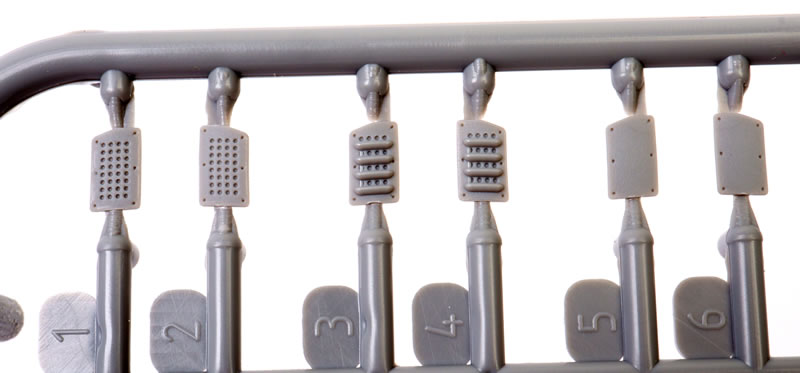
Two sets of exhaust may be found on the sprues - shrouded and unshrouded.
Flaps are supplied as separate parts. They are designed to be built dropped. Note also that the flaps seem to have a subtle oilcanning effect along the lines of recessed rivets. I'm not sure if this is intentional but it looks convincing!
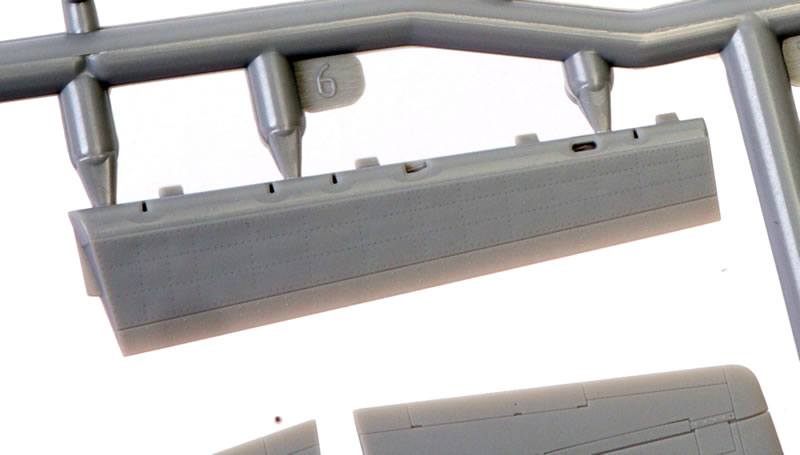
Some cockpit sidewall detail is moulded directly to the inside of the fuselage. Additional separate parts include a plastic cockpit floor, radiator ramps, side console, throttle quadrant; a moulded pair of rudder pedals that fit in behind the instrument panel, control column, fuel tanks, radios and more.
Two styles of pilot's seat and instrument coaming are supplied.
Decals are used extensively for the various cockpit faces. A plastic instrument panel is also supplied with raised bezels and switches. The decal sheet supplies two sets of harness straps and instrument panels. I think decals will be very effective in the front office in this scale.
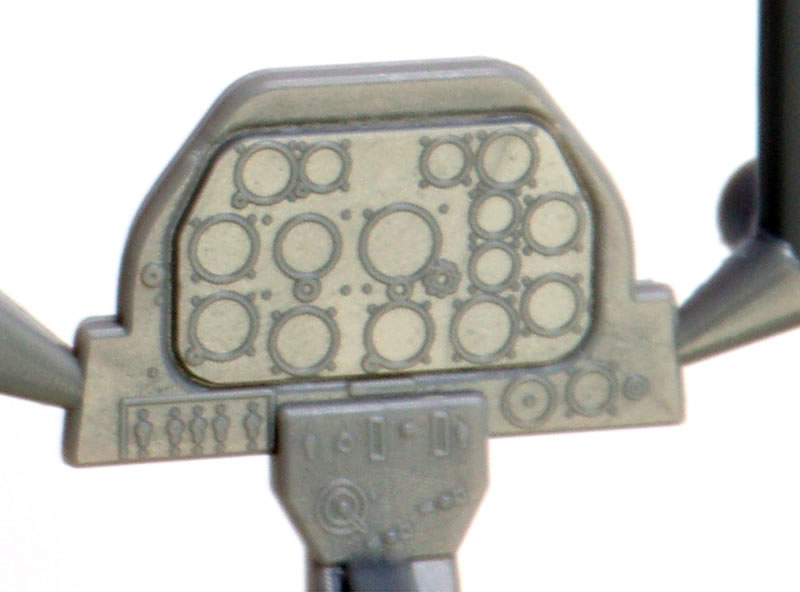
The wing parts are full span, top and bottom. They are thin at the trailing edges. I particularly like the very fine and busy recessed rivets on the centre section of the lower wing.
Wing panel lines and recessed rivets have been toned down on this model to more obviously depict puttied metal.
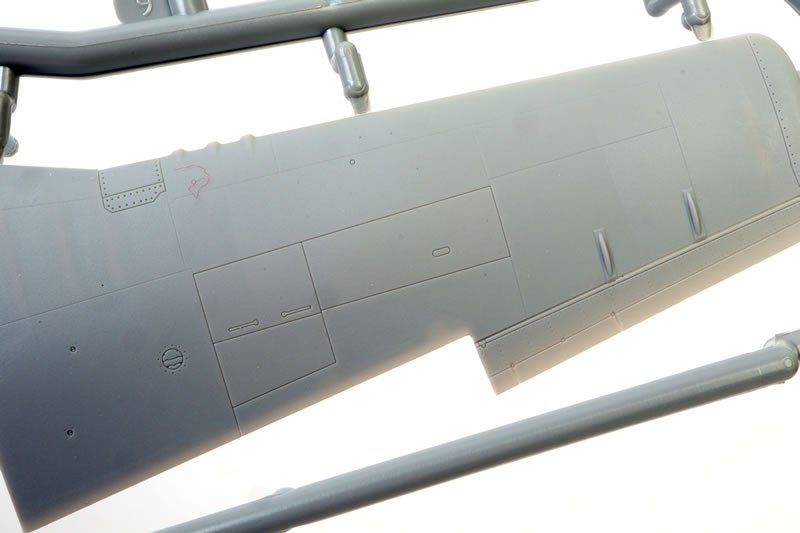
The wheel wells are really nicely detailed and the rear wheel well wall is accurately straight. The chord-wise reinforcements are moulded direcly onto the inner surface of the upper wing, which will make assembly very fast and easy.
In a first as far as I can remember, Arma has provided silver-coloured decals for the wheel well ceiling. Interesting!
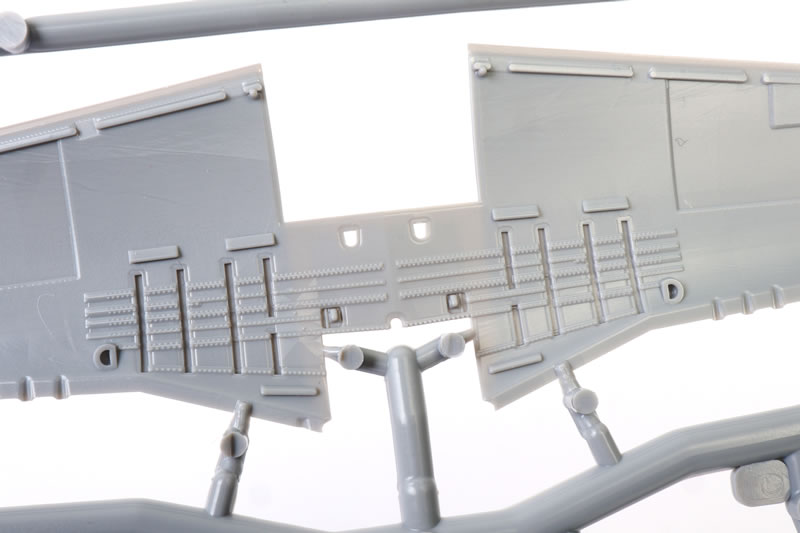
A wing spar is provided to ensure that the dihedral will be the correct angle. This doubles as the rear undercarriage wall.
The main wheels are moulded as one piece each and are excquisitely detailed, including raised lettering. The wheels are subtly bulged and flattened. The tail wheel and strut are moulded as a single part. Detail looks good.
A generous allowance of ordnance is included.
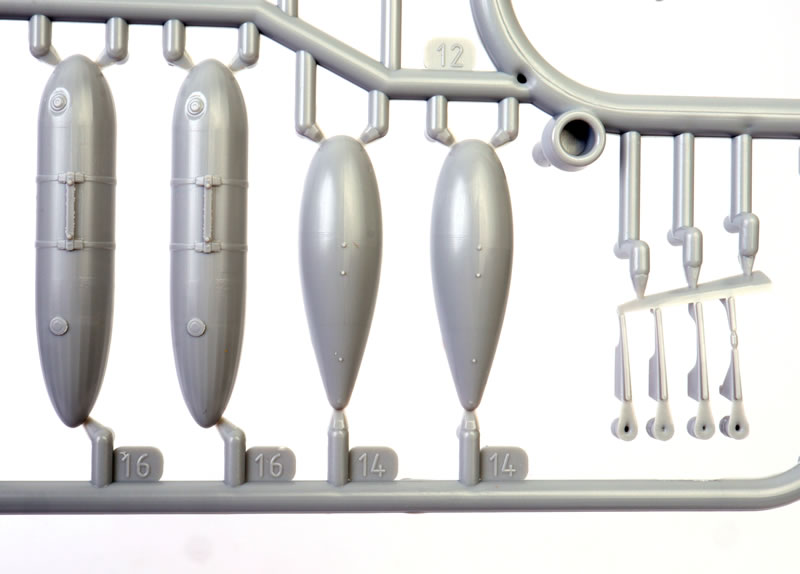
There are two 108 gallon paper tanks, two 90 gallon metal tanks and two 250 lb bombs.
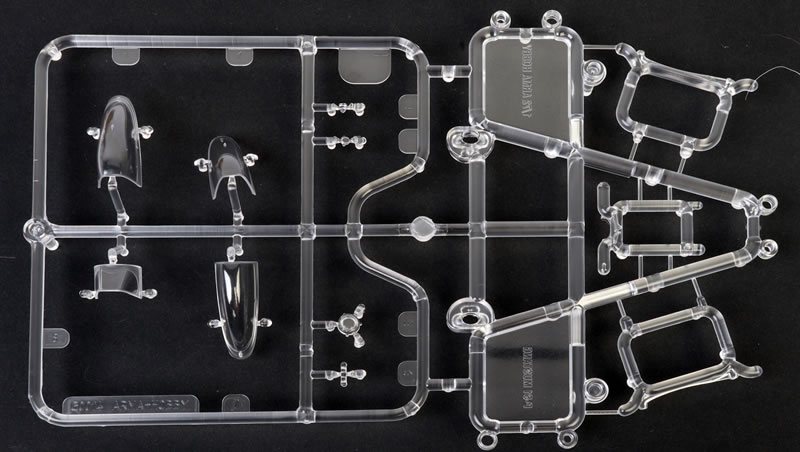
Three styles of canopy are offered. I think they are:
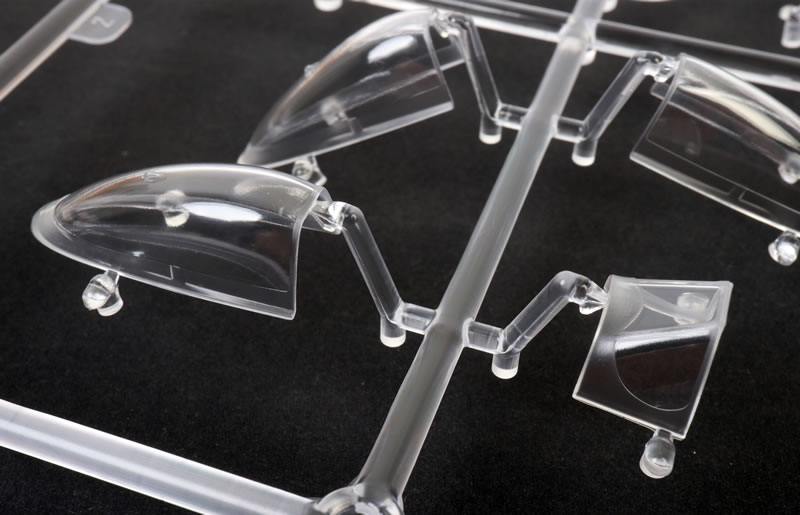
Three sliding section and windscreens are separate parts for all three canopy options.
Navigation and formation lights are moulded as part of the wings.
Self adhesive masks are supplied for the canopies and wheels. These are the paper Kabuki style masks. These will be welcomed by modellers who dislike cutting their own masks.
Instructions are supplied as a 12 page stapled A5-sized booklet.
The kit is packed into a end-opening cardboard box. I have said it before but I have never been a fan of end-opening boxes - access to the parts is more difficult, loose parts can easily be lost while retrieving instructions or a larger sprue, and the format is less structurally rigid, inviting the contents to be crushed when the box is inevitably at the bottom of a pile of kits.
I know it is a nit-pick but I would prefer to see future Arma Hobby releases in a lid-style of box.
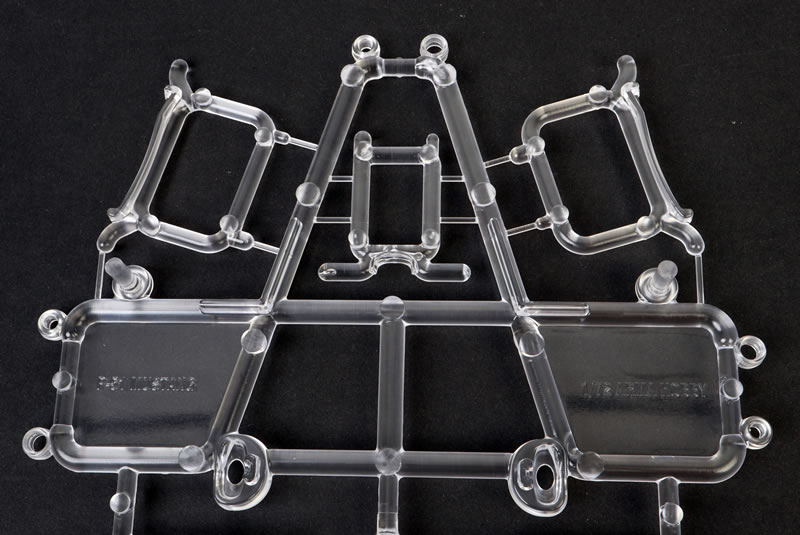
Rounding out the package is a clever alignment jig.
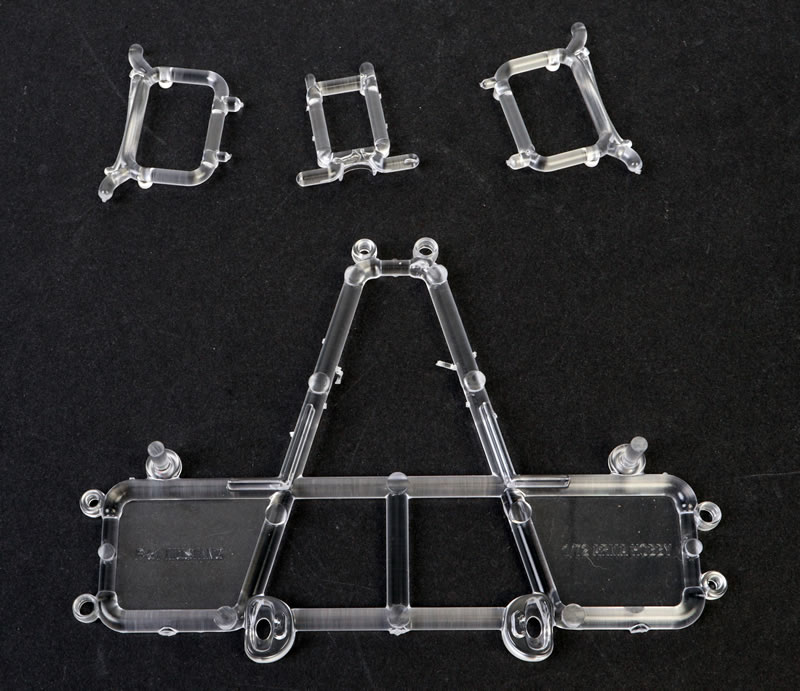
This is made up from four pieces on the clear sprue.
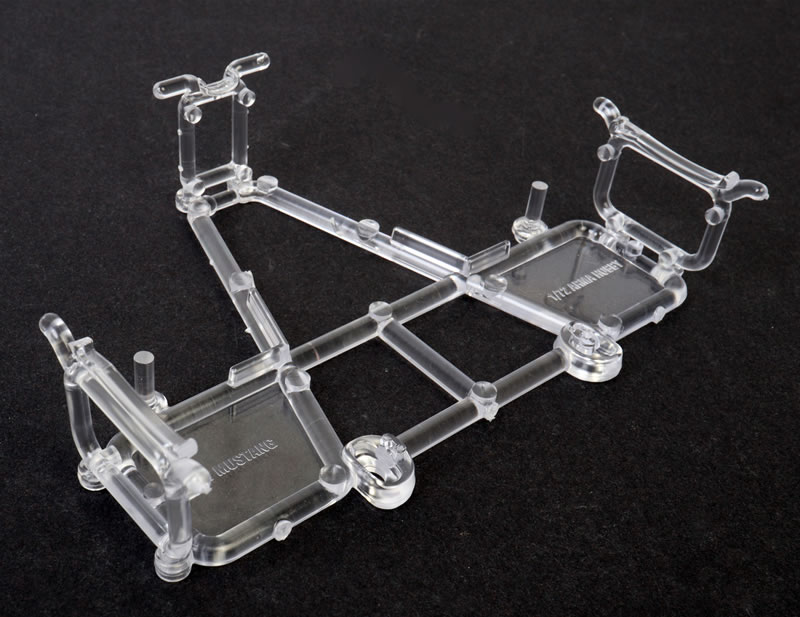
Assembly is fast and easy, and it will guarantee alignment of the wings and the undercarriage.
Marking Options
The kit decal sheet offers markings for three P-51D Mustangs.
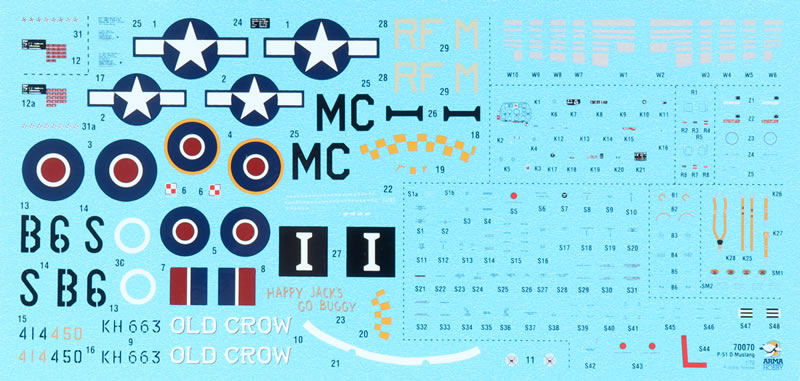
Specifics are:
-
P-51 D-10-NA Mustang, pilot: Lt. Clarence “Bud” Anderson, 375th Fighter Group, 363rd Fighter Squadron, 8th Air Force, RAF Leiston, England, January 1945
-
P-51 D-5-NA Mustang, pilot: Cpt. Jack Ilfrey, 79th Fighter Squadron, 20th Fighter Group, 8th Air Force, RAF Kings Cliffe, England 1944
-
Mustang IV (P-51 D-5 NT), pilot: F/Lt Janusz Franckiewicz, No. 303 (Polish) Squadron, RAF Andrews Field, England, April 1945
One set of US national markings and one set of RAF roundels are included.
Stencil markings are printed on the same single sheet, as are propeller logos.
Colour callouts are provided for FS numbers and model paint numbers from a wide variety of companies – Hakata, AK, Lifecolor, AMMO, Humbrol, Vallejo and Tamiya.
Decals are printed by Techmod. They are glossy, colours are well saturated and everything is in perfect register.
Arma has also supplied bonus decals for a captured Japanese marking option.
This new P-51D is the logical next step in Arma Hobby's 1/72 scale Mustang dynasty. The kit is as impressive as its other Arma Mustang predecessors - crisp surface textures, high moulding quality, many useful options and a very high level of detail.
This a great package with the plastic as well as self-adhesive masks.
Highly Recommended.
Thanks to Arma Hobby for the sample
Review Text and Images Copyright © 2025 by Brett Green
Page Created 14 October, 2025
Last updated
15 October, 2025
Back to HyperScale Main Page
Back to Reviews Page |
Home
| What's New |
Features |
Gallery |
Reviews |
Reference |
Forum |
Search